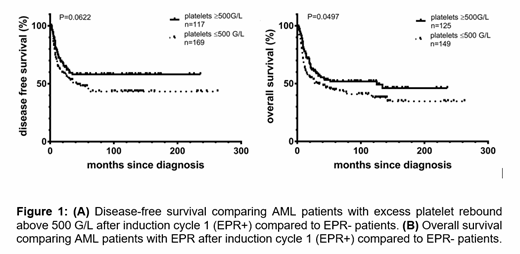Background: Whereas the molecular events underlying acute myeloid leukemia (AML) are increasingly identified, dynamics of hematologic suppression and recovery following induction chemotherapy remain enigmatic. In addition, thrombocytopenia at diagnosis is related to deregulated cytokine expression in specific leukemia subtypes rather than on the degree of bone marrow infiltration per se. Similarly, recovery of platelets after the first induction cycle among individual patients can vary from incomplete to excess recovery even if morphologic remission is achieved. In particular, excess platelet rebound (EPR) with values exceeding 500 G/L can be observed in some patients. However, this clinical observation of EPR is poorly understood so far, and its prognostic relevance is unknown.
Methods: We analyzed platelet recovery after the first induction cycle in 291 consecutive AML patients receiving at least one cycle of intensive "3+7" based induction treatment. We defined excess platelet rebound (EPR) as a platelet increase above 500 G/L during hematologic recovery after the first induction cycle.
Results: We observed EPR in 120 (41.2%) patients. EPR+ patients had lower platelets at diagnosis, higher marrow infiltration, more frequently NPM1 mutations, and were associated with ELN favorable risk. Absence of EPR correlated with complex karyotypes, ELN intermediate-I and adverse risk, and therapy-related AML. Overall survival was better in EPR+ patients than EPR- (median 125 versus 41 months; P=0.04), as was disease-free survival (Figure 1). By multivariate analysis, achievement of EPR+ was an independent parameter associated with favorable survival. Plasma thrombopoietin (TPO) levels at diagnosis indicated EPR+ (p<0.0001), while GATA-1, GATA-2 and MPL mRNA expression did not differ between EPR+ and EPR- patients. Finally, transcription factors blocking early megakaryopoiesis were upregulated in EPR- patients, while NFE2 involved in late megakaryocyte differentiation was increased in EPR+ patients.
Conclusion: This study suggests that excess platelet rebound (EPR+) defined as platelets exceeding 500 G/L is a common event identified in AML patients after the first induction cycle. EPR+ was predominantly observed in ELN favorable risk AML, and it was associated with significantly better overall and disease-free survival as compared to EPR- patients. In addition, achievement of EPR+ represented an independent prognostic parameter for improved survival in a multivariate analysis, and may contribute to prognostic assessment in AML patients undergoing intensive treatment with intention to cure.
No relevant conflicts of interest to declare.
Author notes
Asterisk with author names denotes non-ASH members.


This feature is available to Subscribers Only
Sign In or Create an Account Close Modal